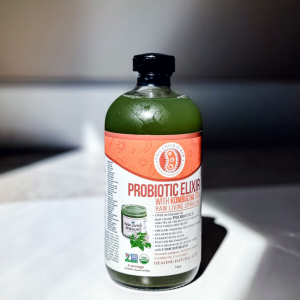These statements have not been evaluated by the Food and Drug Administration and are for informational purposes only. They should not be considered medical advice. Always consult a doctor for medical advice. This product is not intended to diagnose, treat, cure, or prevent any disease.

RAW LIVING SPIRULINA PROBIOTIC ELIXIR

Spirulina (Not powdered) Raw form –
Phytonutrients
Phyto-Nutrients are the most significant finding in nutritional history. These disease-preventing compounds that naturally occur in whole unprocessed and unheated food reveal the magnificence of nature’s genius. These phyto-chemicals are otherwise known as phyto-nutrients, phyto-foods or even nutraceuticals, contain health building elements that strengthen your immune system and your overall body and mind.
Antioxidants
Raw and living foods contain antioxidants which reduce free radical damage and help us age gracefully. Many phytonutrients also act as antioxidants. Antioxidants counteract the damaging effects of “free radicals.” Raw Living Spirulina contains many powerful living antioxidants such as the phytonutrient of Carotenoids: lutein, and zeaxanthin present in macular pigments whose importance is health of the eye.
Enzymes
Living foods contain high frequency enzymes that initiate biochemical reactionsin all living things, plants and animals. Raw Living Spirulina is thriving with living bioactive enzymes, phytonutrients, and cofactors that our body can actually absorb and use intelligently. All chemical reactions within the human body are regulated by enzymes which is why it’s vitally important to consume raw living foods every day.
RAW LIVING SPIRULINA PROBIOTIC ELIXIR

Spirulina (Not powdered) Raw form –
Phytonutrients
Phyto-Nutrients are the most significant finding in nutritional history. These disease-preventing compounds that naturally occur in whole unprocessed and unheated food reveal the magnificence of nature’s genius. These phyto-chemicals are otherwise known as phyto-nutrients, phyto-foods or even nutraceuticals, contain health building elements that strengthen your immune system and your overall body and mind.
Antioxidants
Raw and living foods contain antioxidants which reduce free radical damage and help us age gracefully. Many phytonutrients also act as antioxidants. Antioxidants counteract the damaging effects of “free radicals.” Raw Living Spirulina contains many powerful living antioxidants such as the phytonutrient of Carotenoids: lutein, and zeaxanthin present in macular pigments whose importance is health of the eye.
Enzymes
Living foods contain high frequency enzymes that initiate biochemical reactionsin all living things, plants and animals. Raw Living Spirulina is thriving with living bioactive enzymes, phytonutrients, and cofactors that our body can actually absorb and use intelligently. All chemical reactions within the human body are regulated by enzymes which is why it’s vitally important to consume raw living foods every day.

GRAPE SEED EXTRACT

- “Can reduce blood pressure. Several studies have researched the effects of GSE on high blood pressure.
- Can improve blood flow In one study in 17 healthy postmenopausal women, taking 400 mg of GSE had blood-thinning effects potentially reducing the risk of blood clots
- Could reduce oxidative damage
- May improve collagen levels and bone strength
- Supports your brain as it ages
- Can improve kidney function
- Can inhibit infectious growth
- May reduce cancer risk
- May protect your liver”
“Enhances wound healing and appearance
Several animal studies have found GSE can aid wound healing (50Trusted Source, 51Trusted Source, 52). Human studies show promise as well.”- healthline.com
GRAPE SEED EXTRACT

- “Can reduce blood pressure. Several studies have researched the effects of GSE on high blood pressure.
- Can improve blood flow In one study in 17 healthy postmenopausal women, taking 400 mg of GSE had blood-thinning effects potentially reducing the risk of blood clots
- Could reduce oxidative damage
- May improve collagen levels and bone strength
- Supports your brain as it ages
- Can improve kidney function
- Can inhibit infectious growth
- May reduce cancer risk
- May protect your liver”
“Enhances wound healing and appearance
Several animal studies have found GSE can aid wound healing (50Trusted Source, 51Trusted Source, 52). Human studies show promise as well.”- healthline.com

GREEN TEA

- “Sipping green tea on the regular may help prevent some chronic health conditions and manage others. So far, research has found green tea:
- May improve mental health
There is a chemical explanation for why sipping a hot cup of green tea can be so relaxing. Tea—along with some mushrooms—contains an amino acid called theanine, which research has found may:
- Relieve stress
- Induce relaxation
- Combat anxiety from caffeine
Green tea in particular has the highest concentration of theanine compared to other types of tea like oolong, black, and white tea, according to a 2016 study published in Pharmacognosy Magazine.
- A 2020 review published in Plant Foods for Human Nutrition found that taking a 200 to 400 milligrams (mg) supplement of theanine daily reduced stress and anxiety in people exposed to stressful conditions.
- Another 2019 study, published in Nutrients, of 30 people with no major psychiatric conditions found that those who took 200 mg a day of theanine for four weeks saw greater improvements in depression, anxiety, and sleep compared to those who took a placebo.”
“While both these studies highlight the potential mental health benefits of theanine, the amounts of theanine they used is much more than the amount you would find in a cup or two of green tea.
Might enhance memory
Research has also found that green tea can improve memory, partially thanks to its theanine content. For example, a 2014 study published in Psychopharmacology of 12 healthy volunteers found that green tea extract improved subjects working memory—a type of short-term memory important for planning, comprehension, reasoning, and problem-solving.
Patients were given a milk-based drink that contained either 27.5 mg green tea extract or a placebo. They then completed certain tasks while an MRI tracked their brain activity. Those who consumed the green tea extract saw greater brain connectivity—aka how well different areas of the brain work together—as well as improved working memory and task performance.
Since the study used such a small sample of patients, the results are less definitive. More research is needed to further explore how green tea influences memory.
Protection against neurodegenerative diseases
- Some research has found drinking green tea can protect against certain neurodegenerative diseases, like Alzheimer’s and Parkinson’s. This is likely due to green tea’s high concentration of powerful compounds called antioxidants, according to a 2019 research review published in Molecules. Antioxidants defend cells against damage that, over time, would otherwise lead to neurodegenerative diseases.” -Health.com Cynthia Sass, MPH, RD Updated April 15, 2022
GREEN TEA

- “Sipping green tea on the regular may help prevent some chronic health conditions and manage others. So far, research has found green tea:
- May improve mental health
There is a chemical explanation for why sipping a hot cup of green tea can be so relaxing. Tea—along with some mushrooms—contains an amino acid called theanine, which research has found may:
- Relieve stress
- Induce relaxation
- Combat anxiety from caffeine
Green tea in particular has the highest concentration of theanine compared to other types of tea like oolong, black, and white tea, according to a 2016 study published in Pharmacognosy Magazine.
- A 2020 review published in Plant Foods for Human Nutrition found that taking a 200 to 400 milligrams (mg) supplement of theanine daily reduced stress and anxiety in people exposed to stressful conditions.
- Another 2019 study, published in Nutrients, of 30 people with no major psychiatric conditions found that those who took 200 mg a day of theanine for four weeks saw greater improvements in depression, anxiety, and sleep compared to those who took a placebo.”
“While both these studies highlight the potential mental health benefits of theanine, the amounts of theanine they used is much more than the amount you would find in a cup or two of green tea.
Might enhance memory
Research has also found that green tea can improve memory, partially thanks to its theanine content. For example, a 2014 study published in Psychopharmacology of 12 healthy volunteers found that green tea extract improved subjects working memory—a type of short-term memory important for planning, comprehension, reasoning, and problem-solving.
Patients were given a milk-based drink that contained either 27.5 mg green tea extract or a placebo. They then completed certain tasks while an MRI tracked their brain activity. Those who consumed the green tea extract saw greater brain connectivity—aka how well different areas of the brain work together—as well as improved working memory and task performance.
Since the study used such a small sample of patients, the results are less definitive. More research is needed to further explore how green tea influences memory.
Protection against neurodegenerative diseases
- Some research has found drinking green tea can protect against certain neurodegenerative diseases, like Alzheimer’s and Parkinson’s. This is likely due to green tea’s high concentration of powerful compounds called antioxidants, according to a 2019 research review published in Molecules. Antioxidants defend cells against damage that, over time, would otherwise lead to neurodegenerative diseases.” -Health.com Cynthia Sass, MPH, RD Updated April 15, 2022

ZYGOSACCHAROMYCES BAILII

“Among their potential benefits, yeasts can be used to eliminate cholesterol by assimilation [3] and prevent cardiovascular diseases, considering the failure of current strategies, such as dieting and pharmacological agents [12].
They also can produce major metabolites, such as vitamins [3] and/or enzymes: esterase, protease, or lipase improve digestion by contributing to the absorption of nutrients. A deficiency of digestive enzymes can cause malnutrition, low rate of body development, allergic conditions, digestive disorders, fatigue, liver hypertrophy, or intolerance to certain foods. Another possible characteristic is the antioxidant capability against reactive oxygen species, such as superoxide (O2−) and hydroxyl (OH) radicals, H2O2, and singlet oxygen (1O2), which damage cellular components by oxidizing lipids, proteins, and nucleic acids [13].
On the other hand, probiotics are tackling developing gastrointestinal symptoms, such as abdominal distension, pain, flatulence, and diarrhea, related to lactase metabolism and indigestible oligosaccharides present in pulses and legumes, such as melibiose, raffinose, and stachyose. These kinds of compounds (prebiotics [14]) promote the growth of the microorganisms present in the intestine, resulting in health benefits, such as enhanced antagonism microbiota against foreign microorganisms and contribution of the recolonization of the mucosa, after treatment with antibiotics, generation of H2 and CO2, as well as short-chain fatty acids that should inhibit the growth of pathogenic organisms.”- https://www.ncbi.nlm Published online 2021 Mar 2
ZYGOSACCHAROMYCES BAILII

“Among their potential benefits, yeasts can be used to eliminate cholesterol by assimilation [3] and prevent cardiovascular diseases, considering the failure of current strategies, such as dieting and pharmacological agents [12].
They also can produce major metabolites, such as vitamins [3] and/or enzymes: esterase, protease, or lipase improve digestion by contributing to the absorption of nutrients. A deficiency of digestive enzymes can cause malnutrition, low rate of body development, allergic conditions, digestive disorders, fatigue, liver hypertrophy, or intolerance to certain foods. Another possible characteristic is the antioxidant capability against reactive oxygen species, such as superoxide (O2−) and hydroxyl (OH) radicals, H2O2, and singlet oxygen (1O2), which damage cellular components by oxidizing lipids, proteins, and nucleic acids [13].
On the other hand, probiotics are tackling developing gastrointestinal symptoms, such as abdominal distension, pain, flatulence, and diarrhea, related to lactase metabolism and indigestible oligosaccharides present in pulses and legumes, such as melibiose, raffinose, and stachyose. These kinds of compounds (prebiotics [14]) promote the growth of the microorganisms present in the intestine, resulting in health benefits, such as enhanced antagonism microbiota against foreign microorganisms and contribution of the recolonization of the mucosa, after treatment with antibiotics, generation of H2 and CO2, as well as short-chain fatty acids that should inhibit the growth of pathogenic organisms.”- https://www.ncbi.nlm Published online 2021 Mar 2

HANSENIASPORA VINEAE

Interest in the use of non-Saccharomyces yeasts in winemaking has been increasing due to their positive contributions to wine quality. The non-Saccharomyces yeast Hanseniaspora vineae is an apiculate yeast that has been associated with the production of wine with good aromatic properties. However, little is known about the fermentation dynamics of H. vineae in natural must and its interaction with autochthonous yeasts. In the present study, we performed semi industrial fermentations of Macabeo and Merlot musts inoculated with either H. vineae or S. cerevisiae. The yeast population dynamics were monitored by plate culturing, PCR-DGGE and massive sequencing techniques. The results obtained with these techniques show that H. vineae was able dominate the autochthonous microbiota in Macabeo must but not in Merlot must, which exhibited a larger, more diverse yeast population. The presence of H. vineae throughout most of the Macabeo fermentation resulted in more fruity and flowery wine, as indicated by the chemical analysis of the final wines, which demonstrated a strong presence of phenyl ethyl acetate at concentrations higher than the threshold of perception and approximately 50 times more than that produced in wines fermented with S. cerevisiae. This compound is associated with fruity, floral and honey aromas.
HANSENIASPORA VINEAE

Interest in the use of non-Saccharomyces yeasts in winemaking has been increasing due to their positive contributions to wine quality. The non-Saccharomyces yeast Hanseniaspora vineae is an apiculate yeast that has been associated with the production of wine with good aromatic properties. However, little is known about the fermentation dynamics of H. vineae in natural must and its interaction with autochthonous yeasts. In the present study, we performed semi industrial fermentations of Macabeo and Merlot musts inoculated with either H. vineae or S. cerevisiae. The yeast population dynamics were monitored by plate culturing, PCR-DGGE and massive sequencing techniques. The results obtained with these techniques show that H. vineae was able dominate the autochthonous microbiota in Macabeo must but not in Merlot must, which exhibited a larger, more diverse yeast population. The presence of H. vineae throughout most of the Macabeo fermentation resulted in more fruity and flowery wine, as indicated by the chemical analysis of the final wines, which demonstrated a strong presence of phenyl ethyl acetate at concentrations higher than the threshold of perception and approximately 50 times more than that produced in wines fermented with S. cerevisiae. This compound is associated with fruity, floral and honey aromas.

PICHIA MEMBRANIFACIENS

“Strains and general media. Pichia membranifaciens CYC 1086 was the killer toxin producer used in this study (Complutense Yeast Collection, Complutense University of Madrid, Spain), originally isolated from olive brines (Marquina et al., 1992), identified according to conventional methods used in yeast taxonomy and deposited at the Portuguese Yeast Culture Collection (PYCC, Caparica, Portugal). The killer toxin from P. membranifaciens CYC 1086 (named PMKT2) was compared in the present study with PMKT obtained from P. membranifaciens CYC 1106 (Santos & Marquina, 2004a; Santos et al., 2005, 2007). The sensitive strain used for routine killer assays was Candida boidinii IGC 3430 (PYCC), originally isolated from olive brines. C. boidinii has been linked to pernicious effects (lipolytic activity and lactic acid assimilation) on the fermentation of olive brines. The strains were maintained on agar slants containing 0.5 % (w/v) yeast extract (Difco), 1 % peptone (Difco), 2 % glucose and 2 % agar at 20 °C. Yeast isolates were obtained from Tempranillo grapes and grape skins from Spanish vineyards and wine fermentations of the Ribera del Duero region. These strains were gifts from Dr E. Navascues (Agrovin SA), isolated and identified according to conventional methods used in yeast taxonomy (Kurtzman & Fell, 1998).
For the purpose of killer toxin production and purification, P. membranifaciens CYC 1086 was cultured in buffered YMB medium [1 % (w/v) glucose, 0.3 % (w/v) yeast extract (Difco), 0.3 % (w/v) malt extract (Difco) and 0.5 % (w/v) proteose peptone no. 3 (Difco)]. The medium was buffered to pH 4.5 with 0.2 M sodium citrate/phosphate. Killer activity was determined in YMAMB: YMA (YMB with agar) supplemented with 30 mg of methylene blue per litre, 6 % (w/v) NaCl and 2 % (w/v) agar (Llorente et al., 1997).
DBDM (Dekkera/Brettanomyces differential medium) plates were used for the distinction and enumeration of B. bruxellensis strains during mixed cultures in must (Rodrigues et al., 2001).” – https://www.microbiologyresearch.org First Published: 01 February 2009
PICHIA MEMBRANIFACIENS

“Strains and general media. Pichia membranifaciens CYC 1086 was the killer toxin producer used in this study (Complutense Yeast Collection, Complutense University of Madrid, Spain), originally isolated from olive brines (Marquina et al., 1992), identified according to conventional methods used in yeast taxonomy and deposited at the Portuguese Yeast Culture Collection (PYCC, Caparica, Portugal). The killer toxin from P. membranifaciens CYC 1086 (named PMKT2) was compared in the present study with PMKT obtained from P. membranifaciens CYC 1106 (Santos & Marquina, 2004a; Santos et al., 2005, 2007). The sensitive strain used for routine killer assays was Candida boidinii IGC 3430 (PYCC), originally isolated from olive brines. C. boidinii has been linked to pernicious effects (lipolytic activity and lactic acid assimilation) on the fermentation of olive brines. The strains were maintained on agar slants containing 0.5 % (w/v) yeast extract (Difco), 1 % peptone (Difco), 2 % glucose and 2 % agar at 20 °C. Yeast isolates were obtained from Tempranillo grapes and grape skins from Spanish vineyards and wine fermentations of the Ribera del Duero region. These strains were gifts from Dr E. Navascues (Agrovin SA), isolated and identified according to conventional methods used in yeast taxonomy (Kurtzman & Fell, 1998).
For the purpose of killer toxin production and purification, P. membranifaciens CYC 1086 was cultured in buffered YMB medium [1 % (w/v) glucose, 0.3 % (w/v) yeast extract (Difco), 0.3 % (w/v) malt extract (Difco) and 0.5 % (w/v) proteose peptone no. 3 (Difco)]. The medium was buffered to pH 4.5 with 0.2 M sodium citrate/phosphate. Killer activity was determined in YMAMB: YMA (YMB with agar) supplemented with 30 mg of methylene blue per litre, 6 % (w/v) NaCl and 2 % (w/v) agar (Llorente et al., 1997).
DBDM (Dekkera/Brettanomyces differential medium) plates were used for the distinction and enumeration of B. bruxellensis strains during mixed cultures in must (Rodrigues et al., 2001).” – https://www.microbiologyresearch.org First Published: 01 February 2009

LOTUS SEED
 “It’s rich in antioxidants and micronutrients and may help slow signs of aging and support heart health, blood sugar management, and weight loss. It’s also versatile and easy to enjoy in many different recipes, including snacks, main dishes, and desserts.” healthline.com May 5, 2021
“It’s rich in antioxidants and micronutrients and may help slow signs of aging and support heart health, blood sugar management, and weight loss. It’s also versatile and easy to enjoy in many different recipes, including snacks, main dishes, and desserts.” healthline.com May 5, 2021
LOTUS SEED
“It’s rich in antioxidants and micronutrients and may help slow signs of aging and support heart health, blood sugar management, and weight loss. It’s also versatile and easy to enjoy in many different recipes, including snacks, main dishes, and desserts.” healthline.com May 5, 2021

SEA BUCKTHORNE

“Why do people take sea buckthorn?
- Treat stomach or intestinal problems.
- Improve blood pressure or blood cholesterol.
- Prevent or manage blood vessel or heart disease.
- Complement cancer treatment.
- Boost immunity and prevent infections.
- Treat obesity.
- Improve symptoms of cirrhosis.
- Improve eyesight or dry eyes.”- webmd.com Medically Reviewed by Christine Mikstas, RD, LD on May 20, 2021
SEA BUCKTHORNE

“Why do people take sea buckthorn?
- Treat stomach or intestinal problems.
- Improve blood pressure or blood cholesterol.
- Prevent or manage blood vessel or heart disease.
- Complement cancer treatment.
- Boost immunity and prevent infections.
- Treat obesity.
- Improve symptoms of cirrhosis.
- Improve eyesight or dry eyes.”- webmd.com Medically Reviewed by Christine Mikstas, RD, LD on May 20, 2021

STREPTOCOCCUS THERMOPHILUS
“Probiotics are defined as live microorganisms that when administered in adequate amount confer a health benefit to the host. To be considered as a probiotic, a bacterial strain must not only be safe but should also survive in the human gastrointestinal tract and exert health benefits on its host. Streptococcus thermophilusis a Gram positive bacterium widely used in dairy fermentations for the production of yogurt and cheese. In contrast with other lactic acid bacteria, the probiotic status of thermophilus remains still questioned. This review gives an update of the human trials, in vivo assays in animal models and in vitro experiments, which have assessed the resistance of S. thermophilus to gastrointestinal stresses and have investigated its positive health effects. The underlying mechanisms of action are also described and the probiotic status of the bacterium is debated with respect to the available literature.”- Sciencedirect.com
STREPTOCOCCUS THERMOPHILUS
“Probiotics are defined as live microorganisms that when administered in adequate amount confer a health benefit to the host. To be considered as a probiotic, a bacterial strain must not only be safe but should also survive in the human gastrointestinal tract and exert health benefits on its host. Streptococcus thermophilusis a Gram positive bacterium widely used in dairy fermentations for the production of yogurt and cheese. In contrast with other lactic acid bacteria, the probiotic status of thermophilus remains still questioned. This review gives an update of the human trials, in vivo assays in animal models and in vitro experiments, which have assessed the resistance of S. thermophilus to gastrointestinal stresses and have investigated its positive health effects. The underlying mechanisms of action are also described and the probiotic status of the bacterium is debated with respect to the available literature.”- Sciencedirect.com

EPAZOTE

“Some of the health benefits of epazote may include its ability to reduce flatulence, reduce respiratory conditions, eliminate parasites, improve the metabolism, protect the immune system, help with weight loss efforts, heal wounds, and reduce menstrual discomfort.” Like most other leafy, green vegetables, epazote has a significant level of fiber, which can help improve the digestive process and stimulates the smooth movement of the bowels. By improving the efficiency of the gastrointestinal system, epazote can reduce constipation, cramping, bloating, and even more serious conditions. Traditionally, however, epazote was most commonly used to eliminate flatulence and eliminate indigestion, both of which are always a good thing! [4] Jun 24, 2021 organicfacts.com
EPAZOTE

“Some of the health benefits of epazote may include its ability to reduce flatulence, reduce respiratory conditions, eliminate parasites, improve the metabolism, protect the immune system, help with weight loss efforts, heal wounds, and reduce menstrual discomfort.” Like most other leafy, green vegetables, epazote has a significant level of fiber, which can help improve the digestive process and stimulates the smooth movement of the bowels. By improving the efficiency of the gastrointestinal system, epazote can reduce constipation, cramping, bloating, and even more serious conditions. Traditionally, however, epazote was most commonly used to eliminate flatulence and eliminate indigestion, both of which are always a good thing! [4] Jun 24, 2021 organicfacts.com

PIPER ADUNCUM
Cordoncillo has a variety of traditional uses, including disinfecting wounds, treating respiratory illnesses, stopping blood hemorrhages, and treating gallstones. Since the 1800s, the plant has become known globally as a hemostatic (to help control bleeding) and as an purifier for cuts.
“Cordoncillo negro helps to relieve coughs and sooth throats when battling dry cough. It also expels mucus from the respiratory tract, relieve congestion, relieve pain (including menstrual cramps), speed up wound healing, and addresses inflammation” .Jan 14, 2022 -Alkalineelectric.com
PIPER ADUNCUM

Cordoncillo has a variety of traditional uses, including disinfecting wounds, treating respiratory illnesses, stopping blood hemorrhages, and treating gallstones. Since the 1800s, the plant has become known globally as a hemostatic (to help control bleeding) and as an purifier for cuts.
“Cordoncillo negro helps to relieve coughs and sooth throats when battling dry cough. It also expels mucus from the respiratory tract, relieve congestion, relieve pain (including menstrual cramps), speed up wound healing, and addresses inflammation” .Jan 14, 2022 -Alkalineelectric.com

COLA DE RATON

Helps with digestion, bloating, irritable bowel. Any discomfort related to digestion .
COLA DE RATON

Helps with digestion, bloating, irritable bowel. Any discomfort related to digestion .

MILK THISTLE SEED (SILYBUM MARIANUM)

MILK THISTLE SEED (SILYBUM MARIANUM)


ENTEROCOCCUS FAECIUM

“One of the major benefits of E. faecium is that it is uniquely suited to survive the digestive process and flourish in the gut. It promotes a balanced gut environment by competing for resources that harmful organisms would otherwise consume and use to grow.” Jan 29, 2018- pen+tec consulting.eu
“Probiotics are helpful microbes that encourage good health by assisting with many different processes in the human body. They are probably best known for the contribution they make to gut health and digestion. Probiotics also support gastrointestinal health,[1] aid the immune system, and perform other specialized tasks — every probiotic strain serves a unique purpose. That’s why the best probiotic supplements provide a combination of probiotic strains to promote wellness from multiple angles. Let’s take a look at the benefits offered by Enterococcus faecium; it’s a multitasking strain that is worth considering when you’re looking at probiotic formulas.”- explore.globalhealing.com Published Feb 7, 2017
ENTEROCOCCUS FAECIUM

“One of the major benefits of E. faecium is that it is uniquely suited to survive the digestive process and flourish in the gut. It promotes a balanced gut environment by competing for resources that harmful organisms would otherwise consume and use to grow.” Jan 29, 2018- pen+tec consulting.eu
“Probiotics are helpful microbes that encourage good health by assisting with many different processes in the human body. They are probably best known for the contribution they make to gut health and digestion. Probiotics also support gastrointestinal health,[1] aid the immune system, and perform other specialized tasks — every probiotic strain serves a unique purpose. That’s why the best probiotic supplements provide a combination of probiotic strains to promote wellness from multiple angles. Let’s take a look at the benefits offered by Enterococcus faecium; it’s a multitasking strain that is worth considering when you’re looking at probiotic formulas.”- explore.globalhealing.com Published Feb 7, 2017

BACILLUS VELEZENSIS

Bacillus velezensis gram-positive bacterium, is frequently isolated from diverse niches mainly soil, water, plant roots, and fermented foods. B. velezensis is ubiquitous, non-pathogenic and endospore forming.Dec 6, 2021
*reduces bleeding, musclerelaxant,uterinerelaxant & hormonal
balancing.
BACILLUS VELEZENSIS
Bacillus velezensis gram-positive bacterium, is frequently isolated from diverse niches mainly soil, water, plant roots, and fermented foods. B. velezensis is ubiquitous, non-pathogenic and endospore forming.Dec 6, 2021

LACTOBACILLUS PLANTARUM

“Recently, L. plantarum has been applied in medical fields for the treatment of various chronic and cardiovascular diseases such as Alzheimer’s, Parkinson’s, diabetes, obesity, cancer, hypertension, urinogenital complications, liver disorders.” (Woo et al., 2014) – verywellhealth.com
LACTOBACILLUS PLANTARUM

“Recently, L. plantarum has been applied in medical fields for the treatment of various chronic and cardiovascular diseases such as Alzheimer’s, Parkinson’s, diabetes, obesity, cancer, hypertension, urinogenital complications, liver disorders.” (Woo et al., 2014) – verywellhealth.com

WASAI

Great for kidney health, the root of the Wasai is often ground up and used as a diuretic.
WASAI

Great for kidney health, the root of the Wasai is often ground up and used as a diuretic.

SHAPUMVILLA

“Said to have coagulant properties, this medicinal plant is used to stop bleeding. Very convenient if you get any cuts while exploring on your Amazon vacation.
The above are only 10 of some 30,000 medicinal plants found in the Amazon Rainforest rainforest, many of whose uses have yet to be discovered. You can learn about many of them from the expert natural guides and shaman of the indigenous tribes you may meet on our Amazon tours.”- rainforestcruises.com
SHAPUMVILLA

“Said to have coagulant properties, this medicinal plant is used to stop bleeding. Very convenient if you get any cuts while exploring on your Amazon vacation.
The above are only 10 of some 30,000 medicinal plants found in the Amazon Rainforest rainforest, many of whose uses have yet to be discovered. You can learn about many of them from the expert natural guides and shaman of the indigenous tribes you may meet on our Amazon tours.”- rainforestcruises.com

CANELLILA
Often used to treat women with ovarian cysts, Canellila is also believed to be one of the medicinal plants that could increase the likelihood of conception.
CANELLILA
Often used to treat women with ovarian cysts, Canellila is also believed to be one of the medicinal plants that could increase the likelihood of conception.






